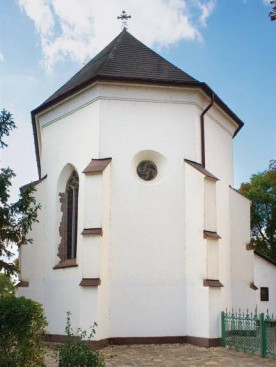The Roman Catholic Church – KisvárdaThe history of the township is connected in many ways to king Saint Ladislaus. Even the Chronicon Pictum by Kálti Márk (Mark of Kált) contains an account of the battle fought by the king against the Cumans. Saint Ladislaus ordered the building of a church on the place of the battle in memory of his victory. According to local tradition, the church in Kisvárda was this memorial church. However, no early diplomas proof such a fact, except one from 1453 saying that the main street in the township was called Saint Ladislaus street. Only archaeological excavations could reveal the foundations of the original church. The first massive extension and rebuild might have occurred at the middle of the 14th century after the Mongol Invasion of Europe. The church built at that time consisted of a nave and a sanctuary ending in a straight line. In the 1470s, a tower was added to the western side and the enclosing of the sanctuary was modified on the eastern side. The wars of the 16th and 17th centuries affected Kisvárda directly. The cenral military role played by the township can be explained by its geographical position. The walls of Kisvárda were exactly in the tampon area between the HungarianKingdom and the Principality of Transylvanian, the former part of the country that profited from the Ottoman occupation and achieved independence. During this period, Kisvárda – defended by its fortress built of stone – became the seat of Szabolcs county and withstood successfully several sieges. It should be mentioned that the most monumental fortress built on the Great Hungarian Plain, and also the ancient nest of the Váradi family, stands in Kisvárda. This fortress reminds us of glorious times. The building of the fortress started in the 15th century and the fortification, naturally, served for the protection of the local population. Since this area is located far away from the mountains, the fortress was built using the clay from the soil near Kisvárda. Using this opportunity, burnt bricks were chosen as building material. This is one of the peculiarities of the edifice since after the fortress in Gyula, it is the largest fortress built of bricks and located on the Great Hungarian Plain. The church, as the settlement itself, survived stormy centuries and a lot of bloodshed. The church suffered massive damage during the autumn of 1558, when Menyhért Balassa laid siege to the town. In 1564, the Transylvanian troops laying siege to Kisvárda, stored their gunpowder in the church and the gunpowder exploded. Moreover, during the anti-Habsburg revolt lead by Stephen Bocskai, the hajduks (hajdú) overwhelmed Kisvárda, set the church on fire and killed the parish priest. In consequence, the ruined church had been demolished. For a while, the Protestants used the wooden facility built instead of the nave, while the Catholics held their sermons in the sanctuary separated from the former by a wall. In 1673, a gang of marauders set the still standing remains of the church on fire. This event forced the restoration of the church between 1722 and 1724. A tower built in Zopfstil, a transitional style between Late Baroque and Classicistic style, has been added to the western end of the present church. Furthermore, during restorations in the 1970s, stone grids were added to the Gothic windows belonging to the sanctuary. However, the circular or rather vesica piscis shaped window on the enclosing wall of the sanctuary is the original one. The figural canopies represent the special attraction of the sanctuary. These canopies belonged to the rib vault ceiling with stone ribs, which was torn down in the 18th century. We can see six canopies carved of red rhyodacite during the late Gothic period. East to the buttress in the northern corner, there is a man’s figure, which is easily identifiable on the basis of the persons’s main attribute and the inscription (Saint Peter). Saint Paul is represented next to him. However, identifying the people on the next three canopies is rather difficult. In Németh Péter’s opinion, two of them might be Saint Sigismund of Burgundy and István Várdai, the archbishop of Kalocsa. The last canopy is embedded in the Baroque style buttress and depicts a bearded man wearing scale armour. He may well be king Saint Ladislaus, as an allusion to the foundation of the church. |















